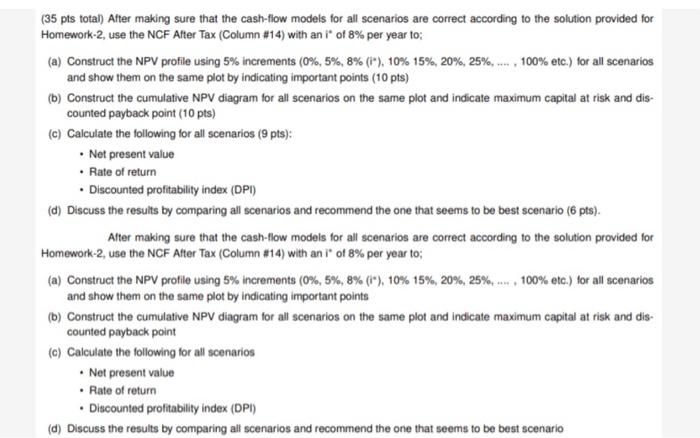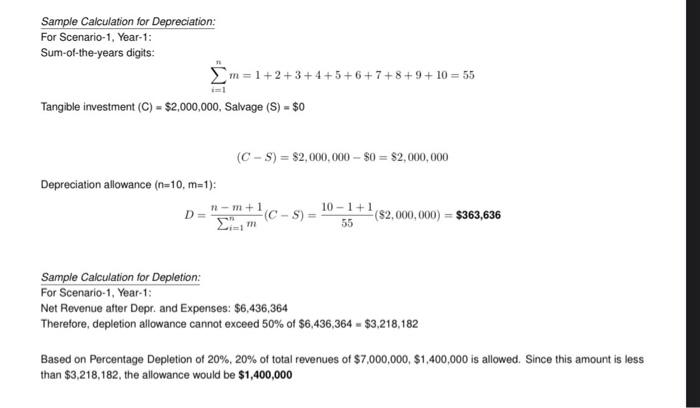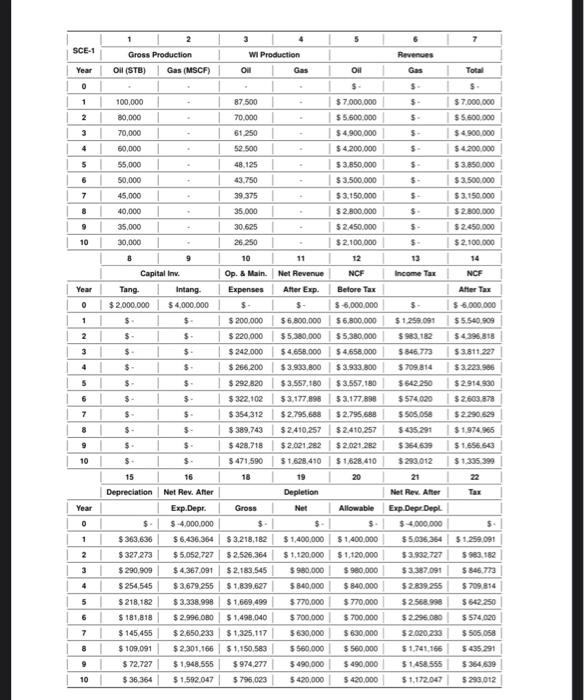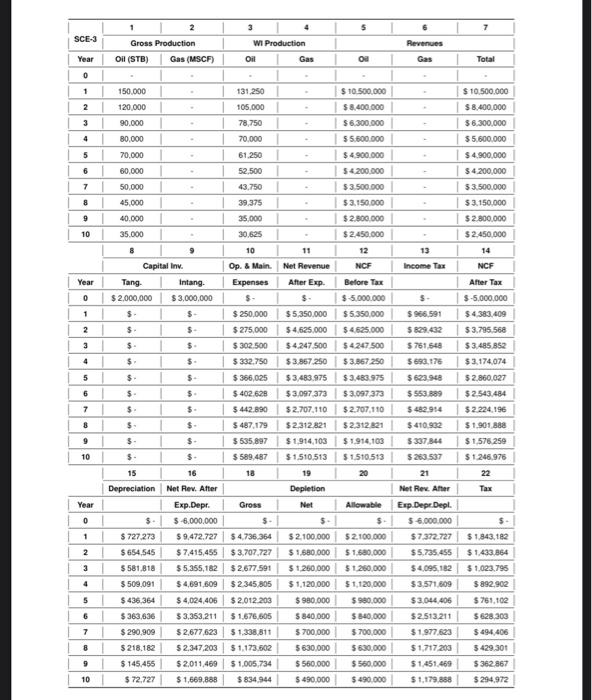(35 pts total) After making sure that the cash-flow models for all scenarios are correct according to the solution provided for Homework-2, use the NCF After Tax (Column \#14) with an i* of 8% per year to: (a) Construct the NPV profile using 5% increments (0%,5%,8%(i),10%,15%,20%,25%,,100% etc.) for all scenarios and show them on the same plot by indicating important points (10 pts) (b) Construct the cumulative NPV diagram for all scenarios on the same plot and indicate maximum capital at risk and discounted payback point (10 pts) (c) Calculate the following for all scenarios (9 pts): - Net present value - Rate of return - Discounted profitability index (DPI) (d) Discuss the results by comparing all scenarios and recommend the one that seems to be best scenario (6 pts). After making sure that the cash-flow models for all scenarios are correct according to the solution provided for Homework-2, use the NCF After Tax (Column #14 ) with an i* of 8% per year to; (a) Construct the NPV profile using 5% increments (0%,5%,8%(i),10%,15%,20%,25%,,100% etc.) for all scenarios and show them on the same plot by indicating important points (b) Construct the cumulative NPV diagram for all scenarios on the same plot and indicate maximum capital at risk and discounted payback point (c) Calculate the following for all scenarios - Net present value - Rate of return - Discounted profitability index (DPI) Sample Calculation for Depreciation: For Scenario-1, Year-1: Sum-of-the-years digits: i=1nm=1+2+3+4+5+6+7+8+9+10=55 Tangible investment (C)=$2,000,000, Salvage (S)=$0 (CS)=$2,000,000$0=$2,000,000 Depreciation allowance (n=10,m=1) : D=i=1nmnm+1(CS)=55101+1($2,000,000)=$363,636 Sample Calculation for Depletion: For Scenario-1, Year-1: Net Revenue after Depr. and Expenses: $6,436,364 Therefore, depletion allowance cannot exceed 50% of $6,436,364=$3,218,182 Based on Percentage Depletion of 20%,20% of total revenues of $7,000,000,$1,400,000 is allowed. Since this amount is less than $3,218,182, the allowance would be $1,400,000 (35 pts total) After making sure that the cash-flow models for all scenarios are correct according to the solution provided for Homework-2, use the NCF After Tax (Column \#14) with an i* of 8% per year to: (a) Construct the NPV profile using 5% increments (0%,5%,8%(i),10%,15%,20%,25%,,100% etc.) for all scenarios and show them on the same plot by indicating important points (10 pts) (b) Construct the cumulative NPV diagram for all scenarios on the same plot and indicate maximum capital at risk and discounted payback point (10 pts) (c) Calculate the following for all scenarios (9 pts): - Net present value - Rate of return - Discounted profitability index (DPI) (d) Discuss the results by comparing all scenarios and recommend the one that seems to be best scenario (6 pts). After making sure that the cash-flow models for all scenarios are correct according to the solution provided for Homework-2, use the NCF After Tax (Column #14 ) with an i* of 8% per year to; (a) Construct the NPV profile using 5% increments (0%,5%,8%(i),10%,15%,20%,25%,,100% etc.) for all scenarios and show them on the same plot by indicating important points (b) Construct the cumulative NPV diagram for all scenarios on the same plot and indicate maximum capital at risk and discounted payback point (c) Calculate the following for all scenarios - Net present value - Rate of return - Discounted profitability index (DPI) Sample Calculation for Depreciation: For Scenario-1, Year-1: Sum-of-the-years digits: i=1nm=1+2+3+4+5+6+7+8+9+10=55 Tangible investment (C)=$2,000,000, Salvage (S)=$0 (CS)=$2,000,000$0=$2,000,000 Depreciation allowance (n=10,m=1) : D=i=1nmnm+1(CS)=55101+1($2,000,000)=$363,636 Sample Calculation for Depletion: For Scenario-1, Year-1: Net Revenue after Depr. and Expenses: $6,436,364 Therefore, depletion allowance cannot exceed 50% of $6,436,364=$3,218,182 Based on Percentage Depletion of 20%,20% of total revenues of $7,000,000,$1,400,000 is allowed. Since this amount is less than $3,218,182, the allowance would be $1,400,000











